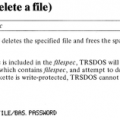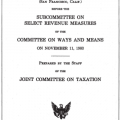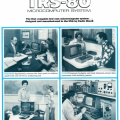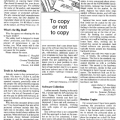Why was the Model I uppercase only?
One of the biggest weaknesses of the TRS-80 Model I was the lack of lowercase characters on the screen. Although that omission was hardly unique to the Model I (many computers at the time lacked lowercase, including the Apple II), it was still a notable limitation that affected many applications, especially word processing.
The two people most responsible for the Model I (originally known as the Radio Shack TRS-80 Microcomputer System) were Don French and Steve Leininger. Don French, described as “the originator of the TRS-80 project,” was a buyer for Radio Shack who had long pushed for Radio Shack to manufacture a microcomputer. Steve Leininger was the engineer who designed almost all of the hardware of the Model I and created the original Level I BASIC.
Steve Leininger mentioned lowercase in a talk he gave to the San Diego Computer Society in September 1977, just one month after the TRS-80 was introduced:
Right now we’re not supporting lowercase, we’ve had enough interest that we may be looking into it, though. There seems to be quite an interest from the word processing industry. In similar manner, with lowercase we may also be looking into expanded number of characters per line, 80 or more. These are things we are looking at for our second and third versions. We sort of see our current computer as square in the middle of no-man’s land. You know, the high-end consumer and the low-end business, and we’re going to branch in both directions.
Cost
So why was lowercase left out of the Model I design? The primary reason was cost. One additional memory chip would have been required to display lowercase characters, and even small costs add up in an inexpensive product.
While the Model I was being developed, many within Radio Shack were opposed to the idea of manufacturing a computer. They didn’t believe that there was a market for a “personal” computer and felt that only a small number (initially set at 1,000) should be produced. There was great pressure to keep the design and product as inexpensive as possible. By the time Model I development was finished, the total development costs amounted to only $100,000.
The original plan was to sell the Model I for $199.00. According to a 1981 article in InfoWorld, this mandated some important design choices:
“The lack of lowercase letters on the first model was not an oversight,” French emphasizes. “We did it on purpose.” The decision saved $1.50 in parts, which translated into $5 on the purchase price, or 2.5% of the target price of $199.
That target price was later increased to $399.00, but the absence of lowercase remained. $399.00 was far, far less expensive than another computer introduced at around the same time: the $1298.00 Apple II.
Demand
As it turned out, Radio Shack had greatly underestimated the demand for the Model I. Instead of the 1,000 computers total they had hoped to sell, they ended up selling 10,000 in just one month. The Model I went on to become the best-selling microcomputer for several years.
There were many third-party lowercase add-ons for the Model I, including the Electric Pencil lowercase modification and Radio Shack’s own lowercase kit. In 1980, Radio Shack introduced the Model III, the eventual replacement for the Model I. Unlike the Model I, the Model III offered lowercase as a standard feature. It wasn’t until 1983 that Apple introduced the Apple IIe, the first version of the Apple II with lowercase standard.














Eric Smith says:
Actually the first Apple with lower case was the Apple III, introduced in 1980. It was intended as a business computer, and was far more expensive than the Apple II.